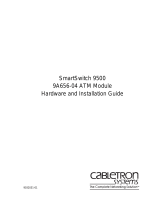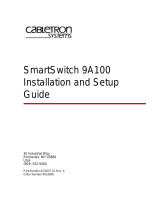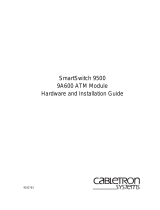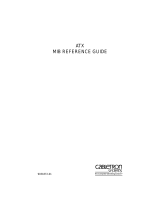Page is loading ...

9032598-02
9A656-04/9A686-04 Configuration Guide


9A656-04/9A686-04 Configuration Guide i
NOTICE
Enterasys Systems reserves the right to make changes in specifications and other information contained in this document without prior
notice. The reader should in all cases consult Enterasys Systems to determine whether any such changes have been made.
The hardware, firmware, or software described in this manual is subject to change without notice.
IN NO EVENT SHALL CABLETRON SYSTEMS BE LIABLE FOR ANY INCIDENTAL, INDIRECT, SPECIAL, OR
CONSEQUENTIAL DAMAGES WHATSOEVER (INCLUDING BUT NOT LIMITED TO LOST PROFITS) ARISING OUT OF OR
RELATED TO THIS MANUAL OR THE INFORMATION CONTAINED IN IT, EVEN IF CABLETRON SYSTEMS HAS BEEN
ADVISED OF, KNOWN, OR SHOULD HAVE KNOWN, THE POSSIBILITY OF SUCH DAMAGES.
1999 by Enterasys Systems, Inc., P.O. Box 5005, Rochester, NH 03866-5005
All Rights Reserved
Printed in the United States of America
Part Number: 9032598-02 February 1999
Enterasys Systems
,
SPECTRUM
, and
LANVIEW
are registered trademarks and
S
ecure
f
ast
,and
SmartSwitch
are trademarks of
Enterasys Systems, Inc.
All other product names mentioned in this manual may be trademarks or registered trademarks of their respective companies.
FCC NOTICE
This device complies with Part 15 of the FCC rules. Operation is subject to the following two conditions: (1) this device may not cause
harmful interference, and (2) this device must accept any interference received, including interference that may cause undesired operation.
NOTE:
This equipment has been tested and found to comply with the limits for a Class A digital device, pursuant to Part 15 of the FCC
rules. These limits are designed to provide reasonable protection against harmful interference when the equipment is operated in a
commercial environment. This equipment uses, generates, and can radiate radio frequency energy and if not installed in accordance with the
operator’s manual, may cause harmful interference to radio communications. Operation of this equipment in a residential area is likely to
cause interference in which case the user will be required to correct the interference at his own expense.
WARNING:
Changes or modifications made to this device which are not expressly approved by the party responsible for compliance could
void the user’s authority to operate the equipment.
Only qualified personnel should perform installation procedures.

Notice
ii 9A656-04/9A686-04 Configuration Guide
INDUSTRY CANADA NOTICE
This digital apparatus does not exceed the Class A limits for radio noise emissions from digital apparatus set out in the Radio Interference
Regulations of the Canadian Department of Communications.
Le présent appareil numérique n’émet pas de bruits radioélectriques dépassant les limites applicables aux appareils numériques de la class A
prescrites dans le Règlement sur le brouillage radioélectrique édicté par le ministère des Communications du Canada.
VCCI NOTICE
This is a Class A product based on the standard of the Voluntary Control Council for Interference by Information Technology Equipment
(VCCI). If this equipment is used in a domestic environment, radio disturbance may arise. When such trouble occurs, the user may be
required to take corrective actions.
CABLETRON SYSTEMS, INC. PROGRAM LICENSE AGREEMENT
IMPORTANT:
Before utilizing this product, carefully read this License Agreement.
This document is an agreement between you, the end user, and Enterasys Systems, Inc. (“Enterasys”) that sets forth your rights and
obligations with respect to the Enterasys software program (the “Program”) contained in this package. The Program may be contained in
firmware, chips or other media. BY UTILIZING THE ENCLOSED PRODUCT, YOU ARE AGREEING TO BECOME BOUND BY THE
TERMS OF THIS AGREEMENT, WHICH INCLUDES THE LICENSE AND THE LIMITATION OF WARRANTY AND DISCLAIMER
OF LIABILITY. IF YOU DO NOT AGREE TO THE TERMS OF THIS AGREEMENT, PROMPTLY RETURN THE UNUSED PRODUCT
TO THE PLACE OF PURCHASE FOR A FULL REFUND.

9A656-04/9A686-04 Configuration Guide iii
Notice
CABLETRON SOFTWARE PROGRAM LICENSE
1. LICENSE
. You have the right to use only the one (1) copy of the Program provided in this package subject to the terms and conditions
of this License Agreement.
You may not copy, reproduce or transmit any part of the Program except as permitted by the Copyright Act of the United States or as
authorized in writing by Enterasys.
2. OTHER RESTRICTIONS. You may not reverse engineer, decompile, or disassemble the Program.
3. APPLICABLE LAW. This License Agreement shall be interpreted and governed under the laws and in the state and federal courts of
New Hampshire. You accept the personal jurisdiction and venue of the New Hampshire courts.
EXCLUSION OF WARRANTY AND DISCLAIMER OF LIABILITY
1. EXCLUSION OF
WARRANTY. Except as may be specifically provided by Enterasys in writing, Enterasys makes no warranty,
expressed or implied, concerning the Program (including its documentation and media).
CABLETRON DISCLAIMS ALL WARRANTIES, OTHER THAN THOSE SUPPLIED TO YOU BY CABLETRON IN WRITING,
EITHER EXPRESSED OR IMPLIED, INCLUDING BUT NOT LIMITED TO IMPLIED WARRANTIES OF MERCHANTABILITY
AND FITNESS FOR A PARTICULAR PURPOSE, WITH RESPECT TO THE PROGRAM, THE ACCOMPANYING WRITTEN
MATERIALS, AND ANY ACCOMPANYING HARDWARE.
2. NO LIABILITY FOR CONSEQUENTIAL DAMAGES. IN NO EVENT SHALL CABLETRON OR ITS SUPPLIERS BE LIABLE
FOR ANY DAMAGES WHATSOEVER (INCLUDING, WITHOUT LIMITATION, DAMAGES FOR LOSS OF BUSINESS,
PROFITS, BUSINESS INTERRUPTION, LOSS OF BUSINESS INFORMATION, SPECIAL, INCIDENTAL, CONSEQUENTIAL,
OR RELIANCE DAMAGES, OR OTHER LOSS) ARISING OUT OF THE USE OR INABILITY TO USE THIS CABLETRON
PRODUCT, EVEN IF CABLETRON HAS BEEN ADVISED OF THE POSSIBILITY OF SUCH DAMAGES. BECAUSE SOME
STATES DO NOT ALLOW THE EXCLUSION OR LIMITATION OF LIABILITY FOR CONSEQUENTIAL OR INCIDENTAL
DAMAGES, OR ON THE DURATION OR LIMITATION OF IMPLIED WARRANTIES, IN SOME INSTANCES THE ABOVE
LIMITATIONS AND EXCLUSIONS MAY NOT APPLY TO YOU.
UNITED STATES GOVERNMENT RESTRICTED RIGHTS
The enclosed product (a) was developed solely at private expense; (b) contains “restricted computer software” submitted with restricted rights
in accordance with Section 52227-19 (a) through (d) of the Commercial Computer Software - Restricted Rights Clause and its successors,
and (c) in all respects is proprietary data belonging to Enterasys and/or its suppliers.
For Department of Defense units, the product is licensed with “Restricted Rights” as defined in the DoD Supplement to the Federal
Acquisition Regulations, Section 52.227-7013 (c) (1) (ii) and its successors, and use, duplication, disclosure by the Government is subject to
restrictions as set forth in subparagraph (c) (1) (ii) of the Rights in Technical Data and Computer Software clause at 252.227-7013. Enterasys
Systems, Inc., 35 Industrial Way, Rochester, New Hampshire 03867-0505.

Notice
iv 9A656-04/9A686-04 Configuration Guide
SAFETY INFORMATION
CLASS 1 LASER TRANSCEIVERS
THE FE-100F3 FAST ETHERNET INTERFACE MODULE, FPIM-05 AND FPIM-07 FDDI PORT
INTERFACE MODULES, APIM-29 AND APIM-29LR ATM PORT INTERFACE MODULES,
ANIM-29/3 , ANIM-29/3LR AND ANIM-39/2 ATM NETWORK INTERFACE MODULES USE CLASS 1
LASER TRANSCEIVERS. READ THE FOLLOWING SAFETY INFORMATION BEFORE
INSTALLING OR OPERATING THESE MODULES.
The Class 1 laser transceivers use an optical feedback loop to maintain Class 1 operation limits. This control loop eliminates the need for
maintenance checks or adjustments. The output is factory set, and does not allow any user adjustment. Class 1 Laser transceivers comply with
the following safety standards:
• 21 CFR 1040.10 and 1040.11 U.S. Department of Health and Human Services (FDA).
• IEC Publication 825 (International Electrotechnical Commission).
• CENELEC EN 60825 (European Committee for Electrotechnical Standardization).
When operating within their performance limitations, laser transceiver output meets the Class 1 accessible emission limit of all three
standards. Class 1 levels of laser radiation are not considered hazardous.
SAFETY INFORMATION
CLASS 1 LASER TRANSCEIVERS
LASER RADIATION AND CONNECTORS
When the connector is in place, all laser radiation remains within the fiber. The maximum amount of radiant power exiting the fiber (under
normal conditions) is -12.6 dBm or 55 x 10
-6
watts.
Removing the optical connector from the transceiver allows laser radiation to emit directly from the optical port. The maximum radiance
from the optical port (under worst case conditions) is
0.8 W cm
-2
or 8 x 10
3
W m
2
sr-1.
Do not use optical instruments to view the laser output. The use of optical instruments to view laser output increases eye hazard.
When viewing the output optical port, power must be removed from the network adapter.

9A656-04/9A686-04 Configuration Guide v
Notice
DECLARATION OF CONFORMITY
Application of Council Directive(s):
89/336/EEC
73/23/EEC
Manufacturer’s Name:
Enterasys Systems, Inc.
Manufacturer’s Address:
35 Industrial Way
PO Box 5005
Rochester, NH 03867
European Representative Name:
Mr. J. Solari
European Representative Address:
Enterasys Systems Limited
Nexus House, Newbury Business Park
London Road, Newbury
Berkshire RG13 2PZ, England
Conformance to Directive(s)/Product Standards:
EC Directive 89/336/EEC
EC Directive 73/23/EEC
EN 55022
EN 50082-1
EN 60950
Equipment Type/Environment:
Networking Equipment, for use in a Commercial or
Light Industrial Environment.
We the undersigned, hereby declare, under our sole responsibility, that the equipment packaged with this notice conforms
to the above directives.
Manufacturer Legal Representative in Europe
Mr. Ronald Fotino Mr. J. Solari
___________________________________ ___________________________________
Full Name Full Name
Principal Compliance Engineer Managing Director - E.M.E.A.
___________________________________ ___________________________________
Title Title
Rochester, NH, USA Newbury, Berkshire, England
___________________________________ ___________________________________
Location Location

Notice
vi 9A656-04/9A686-04 Configuration Guide

9A656-04/9A686-04 Configuration Guide vii
CONTENTS
CHAPTER 1 INTRODUCTION
1.1 Using This Guide.......................................................................................... 1-1
1.2 Document Conventions ................................................................................ 1-2
1.3 Overview.......................................................................................................1-3
1.3.1 Distributed Management Framework.............................................. 1-4
1.3.2 ATM Forum Specifications.............................................................. 1-4
1.3.3 ATM Traffic Types........................................................................... 1-4
1.3.4 MIB Support....................................................................................1-5
1.3.5 Distributed Clocking........................................................................1-5
1.3.6 ATM Adaptation Layer (AAL) Support.............................................1-6
1.3.7 Management LAN Emulation Client................................................1-6
1.4 Interface (Port) Numbering........................................................................... 1-6
1.5 Default Settings Upon First Initialization....................................................... 1-7
1.5.1 9A686-04 Initialization Steps...........................................................1-7
1.5.2 Additional Default Settings..............................................................1-9
1.6 Configurable Options..................................................................................1-10
1.6.1 Configurable Options at the System (Chassis) Level....................1-10
1.7 Local Management Screen Elements......................................................... 1-12
1.7.1 Local Management Keyboard Conventions..................................1-14
1.8 Getting Help................................................................................................ 1-15
1.9 Related Manuals......................................................................................... 1-16
CHAPTER 2 SYSTEM CONFIGURATION
2.1 Selecting Local Management Menu Screen Items....................................... 2-2
2.2 Exiting Local Management Screens............................................................. 2-2
2.3 Accessing the Main Menu Screen................................................................ 2-3
2.4 The Main Menu Screen ................................................................................ 2-4
2.5 The Chassis Menu Screen ........................................................................... 2-5
2.6 Chassis Configuration Screen...................................................................... 2-6
2.6.1 Setting the IP Address .................................................................... 2-8
2.6.2 Setting the Chassis Date.................................................................2-9
2.6.3 Setting the Chassis Time................................................................2-9
2.6.4 Entering a New Screen Update Time............................................2-10
2.7 SNMP Community Names Screen ............................................................. 2-11
2.7.1 Establishing Community Names...................................................2-12

Contents
viii 9A656-04/9A686-04 Configuration Guide
2.8 SNMP Traps Screen...................................................................................2-13
2.8.1 Configuring the Trap Table............................................................2-14
2.9 The Chassis Power Screen.........................................................................2-15
2.10 The Module Selection Screen.....................................................................2-17
2.10.1 Selecting a Module........................................................................2-17
2.11 The Module Menu Screen for the 9A686-04...............................................2-18
2.12 The Module Configuration Menu Screen ....................................................2-19
2.13 The General Configuration Screen .............................................................2-20
2.13.1 Entering a New Screen Refresh Time...........................................2-21
2.13.2 Setting the Screen Lockout Time ..................................................2-22
2.13.3 Setting the TFTP Gateway IP Address..........................................2-22
2.13.4 Setting the Default Gateway..........................................................2-23
2.13.5 Setting the Default Interface..........................................................2-23
2.14 The Module Specific Configuration Screen.................................................2-24
2.15 System Configuration Menu Screen ...........................................................2-26
2.16 The PNNI Configuration Screen..................................................................2-27
2.16.1 PNNI Configuration Screen Fields.................................................2-28
2.16.2 Setting the PNNI Mode..................................................................2-31
2.16.3 Setting the NSAP Prefix ................................................................2-31
2.16.4 Setting the PNNI Level..................................................................2-31
2.17 The ILMI Configuration Menu Screen.........................................................2-32
2.17.1 ILMI Configuration Menu Screen Fields........................................2-33
2.17.2 Setting the MIN SVCC VCI Field...................................................2-33
2.17.3 Setting the MAX SVCC VPI Field..................................................2-34
2.17.4 Setting the MAX SVPC VPI Field..................................................2-34
2.18 The ATM Diagnostics Screen .....................................................................2-35
2.18.1 Enabling/Disabling ATM Diagnostics.............................................2-35
2.19 Module Configuration Menu Screen............................................................2-36
2.19.1 Module Configuration Menu Screen Fields ...................................2-36
2.20 Port Status Screen......................................................................................2-38
2.20.1 Port Status Screen Fields..............................................................2-38
2.21 Port Errors Screen ......................................................................................2-42
2.21.1 Port Errors Screen Fields..............................................................2-42
2.22 EPD/PPD Configuration Menu Screen........................................................2-44
2.22.1 EPD/PPD Configuration Menu Screen Fields ...............................2-44
2.22.2 Configuring EPD/PPD ...................................................................2-45
2.23 SPVC Connection Management Menu Screen...........................................2-46
2.23.1 SPVC Connection Management Menu Screen Fields...................2-46
2.24 SPVC Source Creation Screen...................................................................2-47
2.24.1 SPVC Source Creation Screen Fields...........................................2-47
2.24.2 Creating the Source End of an SPVP............................................2-49
2.24.3 Creating the Source End of a SPVC .............................................2-51

9A656-04/9A686-04 Configuration Guide ix
Contents
2.25 SPVC Destination Creation Screen............................................................ 2-53
2.25.1 SPVC Destination Creation Screen Fields.................................... 2-53
2.25.2 Creating the Destination End of an SPVP.....................................2-55
2.25.3 Creating the Destination End of a SPVC ...................................... 2-56
2.26 LAN Emulation Menu Screen ..................................................................... 2-57
2.26.1 LAN Emulation Client Menu Screen Fields...................................2-58
2.27 LAN Emulation Client Properties Screen....................................................2-59
2.27.1 LAN Emulation Client Properties Screen Fields............................2-59
2.28 LAN Emulation Client Administration Screen ............................................. 2-63
2.28.1 LAN Emulation Client Administration Screen Fields.....................2-63
2.28.2 Configuring the LEC Automatically ............................................... 2-65
2.28.3 Configuring the LEC Manually ...................................................... 2-66
2.29 Network Tools.............................................................................................2-67
2.29.1 Built-in Commands........................................................................ 2-68
2.29.2 Special Commands.......................................................................2-74
2.30 The Environmental Module Screen ............................................................ 2-75
2.30.1 Setting the Fan Speeds.................................................................2-77
2.30.2 Enabling/Disabling COM1 and COM2...........................................2-77
2.30.3 Changing the COM2 Application................................................... 2-78
2.30.4 Downloading a New Image into Flash Memory.............................2-78
2.31 Creating a PVC........................................................................................... 2-79
2.31.1 Getting the Traffic Descriptor........................................................2-79
2.31.2 Adjusting ILMI Parameters for PVC Creation................................2-79
2.31.3 Setting the Instance of the First Interface ..................................... 2-81
2.31.4 Setting the Traffic Descriptor for the Receive Side
of the Interfaces ............................................................................ 2-82
2.31.5 Setting the Traffic Descriptor for the Transmit
Side of the Interfaces....................................................................2-83
2.31.6 Setting the VCL Status to Active...................................................2-84
2.31.7 Getting the Cross-Connect Identifier (CCID).................................2-85
2.31.8 Activating the PVC........................................................................2-86
CHAPTER 3 ILMI 4.0 AND THE SMARTSWITCH 9500 SYSTEM
3.1 ILMI Autoconfiguration Examples................................................................. 3-1
3.2 Port Status Screen........................................................................................ 3-5
3.3 ILMI Configuration Screen............................................................................ 3-7

Contents
x 9A656-04/9A686-04 Configuration Guide
CHAPTER 4 SIGNALLING AND ROUTING
4.1 Persistence ...................................................................................................4-1
4.2 Signalling Overview.......................................................................................4-2
4.2.1 Stack Types.....................................................................................4-2
4.2.2 Configuration...................................................................................4-2
4.2.3 Setting Types...................................................................................4-3
4.2.4 Setting Sides ...................................................................................4-5
4.3 Routing Overview..........................................................................................4-7
4.3.1 PNNI Overview................................................................................4-7
4.3.2 Peer Groups....................................................................................4-8
4.3.3 Crankback .......................................................................................4-9
4.3.4 GCAC............................................................................................4-10
4.3.5 Addressing.....................................................................................4-10
4.4 IISP Overview .............................................................................................4-10
4.4.1 Supported UNI Signalling Versions...............................................4-10
4.4.2 UNI Sides ......................................................................................4-10
4.5 Configuring IISP..........................................................................................4-11
4.5.1 Signalling Configuration.................................................................4-12
4.5.1.1 Step 1: Set the IISP Signalling Version and Type.........4-12
4.5.1.2 Step 2: Set the IISP Side...............................................4-14
4.6 Creating and Configuring a Reachable Address (Static Route)..................4-16
4.6.1 Step 1: Create a Row in the pnniRouteAddrTable ........................4-17
4.6.2 Step 2: Associate the Reachable Address with Its
Advertising Node ID.......................................................................4-19
4.6.3 Step 3: Associate the Reachable Address with a Port ID..............4-21
4.6.4 Step 4: Associate the Reachable Address with an Interface.........4-23
APPENDIX A ACRONYMS
APPENDIX B DEFAULT SETTINGS
B.1 SmartSwitch 9500 System Settings................................................................ B-1
B.1.1 IP Addresses........................................................................................ B-1
B.1.2 SNMP Community Names.................................................................... B-1
B.1.3 SNMP Traps......................................................................................... B-1
B.1.4 Signalling.............................................................................................. B-1
B.1.5 ILMI Settings......................................................................................... B-2
B.1.6 Management LAN Emulation Client ..................................................... B-2
B.1.7 PNNI Settings....................................................................................... B-2
B.1.8 Clocking................................................................................................ B-2
B.1.9 Maximum Number of Connections....................................................... B-2

9A656-04/9A686-04 Configuration Guide xi
Contents
APPENDIX C SUPPORTED MIBS
C.1 MIB, SMI, MIB Files and Internet MIB Hierarchy.............................................C-1
C.2 SmartSwitch 9500 MIB Hierarchy ...................................................................C-3

Contents
xii 9A656-04/9A686-04 Configuration Guide

9A656-04/9A686-04 Configuration Guide Page 1-1
CHAPTER 1
INTRODUCTION
Welcome to the Enterasys Systems
9A656-04/9A686-04 Configuration Guide.
This guide
describes the management features of the 9A656-04/9A686-04 and how to configure the
modules and SmartSwitch 9500 chassis via Local Management screens and MIBs, and
includes information concerning network requirements and troubleshooting.
1.1 USING THIS GUIDE
Read through this guide completely to understand the features, capabilities, Local
Management Functions, and MIB support of the 9A686-04 and the SmartSwitch 9500 chassis.
The following list provides an overview of each section in this manual:
Chapter 1,
Introduction
, provides a brief overview of the management features of the
9A686-04, describes the interface numbering scheme used by the 9A686-04, provides an
overview of the configurable options of the modules and the entire system (SmartSwitch
9500), provides instructions on getting help and concludes with a list of related manuals.
NOTE
This is a draft manual for the 9A686-04 only. Additional information regarding PNNI
local management screens will be added to the next revision.
NOTE
In this document, the Cabletron Systems SmartSwitch 9000 chassis is referred to
as the “SmartSwitch 9500 chassis” which indicates a SmartSwitch 9000 chassis
with a CTM backplane and one or more 9A656-04/9A686-04 modules installed.
Unless noted differently, this guide applies to both the 9A656-04 and 9A686-04 ATM
SmartSwitch modules, which are referred to as the “9A686-04”.
NOTE
This guide is for Cabletron Systems service personnel and QUALIFIED customer
maintenance personnel who are familiar with installing networking systems, and
have a working knowledge of ATM networks, and for system managers and others
who perform network management tasks.

Chapter 1:
Introduction
Page 1-2 9A656-04/9A686-04 Configuration Guide
Chapter 2,
Basic System Configuration
, provides instructions on setting the In-Band,
Out-Of-Band, and SMB-10 IP Addresses, setting SNMP Community Names and SNMP
Traps, viewing chassis power supply information, creating PVCs and SPVCs, configuring
PNNI for the SmartSwitch 9500, setting ILMI parameters, configuring the management LEC,
and configuring the Environmental Module of the SmartSwitch 9500 chassis.
Chapter 3,
ILMI 4.0 and the SmartSwitch 9500 System
, provides information on how the
SmartSwitch 9500 uses ILMI 4.0 to auto-configure signalling stacks and sides depending on
the requirements of the network, with no user input required.
Chapter 4,
Signalling and Routing
, provides information and instructions on how to use
MIBs to force individual interfaces to use specific Signalling stacks and sides, how to
configure an IISP interface via MIB tools, and provides a brief overview of PNNI 1.0 support
of the SmartSwitch 9500.
Appendix A,
Acronyms
, provides a list of acronyms commonly used in this document.
Appendix B,
Default Settings
, provides information on the default settings the SmartSwitch
9500 system has upon first initialization, and cross references to sections of this manual where
these settings may be changed.
Appendix C,
Supported MIBs
, provides tables that detail all of the MIB branches and branch
leaves supported by the SmartSwitch 9500 system.
1.2 DOCUMENT CONVENTIONS
The following conventions are used throughout this document:
NOTE
Note
symbol. Calls the reader’s attention to any item of information that may be of
special importance.
!
CAUTION
Caution
symbol. Contains information essential to avoid damage to the equipment.
TIP
Tip
symbol. Conveys helpful hints concerning procedures or actions.

9A656-04/9A686-04 Configuration Guide Page 1-3
Overview
1.3 OVERVIEW
The following two subsections provide brief overviews of the 9A656-04 and the 9A686-04
respectively:
9A656-04
The 9A656-04 is a 4.5 Gbps, single slot module for the SmartSwitch 9500 chassis. Up to four
ATM Network Interface Modules (ANIMs) of any type can be installed in the 9A656-04 to
provide front panel connectivity to the network. Enterasys Systems ANIMs can support up to
622 Mbps of bandwidth per port. The 9A656-04 switches data between the ANIMs and the
Cell Transfer Matrix (CTM) backplane in the SmartSwitch 9500 chassis. This allows for
high-speed switching of data between modules installed in the same chassis that connect to
the CTM backplane. The CTM provides a dedicated 1.6 Gbps link between each 9A656-04
module.
9A686-04
The 9A686-04 is a 5.4 Gbps, single slot module for the SmartSwitch 9500 chassis. Up to four
ATM Network Interface Modules (ANIMs) of any type can be installed in the 9A686-04 to
provide front panel connectivity to the network. Enterasys Systems ANIMs can support up to
622 Mbps of bandwidth per port. The 9A686-04 switches data between the ANIMs and the
Cell Transfer Matrix (CTM) backplane in the SmartSwitch 9500 chassis. This allows for
high-speed switching of data between modules installed in the same chassis that connect to
the CTM backplane. The CTM provides a dedicated 1.6 Gbps link between each 9A686-04
module.

Chapter 1:
Introduction
Page 1-4 9A656-04/9A686-04 Configuration Guide
1.3.1 Distributed Management Framework
Through its distributed management framework, the 9A686-04 allows all the modules in the
chassis to appear as a single entity, managed through a single IP address. The individual
modules are transparent to the network manager and management applications. A fully loaded
SmartSwitch 9500 chassis appears as a single switch, with one IP address.
1.3.2 ATM Forum Specifications
The 9A686-04 is fully compliant with the following ATM Forum specifications:
•
Intergrated Local management Interface (ILMI) 4.0 for autoconfiguration.
•
UNI v3.0 /3.1 and v4.0 for signalling.
•
ATM Forum P-NNI 1.0 and IISP 3.0/3.1/4.0 routing specifications for establishing
connections between ATM switches.
•
LANE 1.0 for the management LAN Emulation Client.
•
TM 4.0
1.3.3 ATM Traffic Types
The 9A686-04 supports the following standard ATM traffic classes:
•
Constant Bit Rate (CBR): ATM traffic class that is guaranteed a fixed amount of bandwidth
while the Virtual Circuit (VC) is active.
•
Variable Bit Rate (VBR): ATM traffic class that varies the amount of bandwidth used on the
VC while the VC is active, while maintaining a minimum CBR component.
•
Available Bit Rate (ABR): ATM traffic class that allows VCs to use the greatest amount of
bandwidth available on the link at any point in time.
•
Unspecified Bit Rate (UBR): ATM traffic class that does not contain any bandwidth
guarantees.
NOTE
“
Throughout this manual, it is important to understand that the 9A656-04/9A686-04
are part of an overall “system” which is the SmartSwitch 9500. With one or more
9A656-04/9A686-04s installed, the chassis becomes a single switch, with all boards
installed being a part of that single switch, not a separate component.
When this manual refers to the “system” it is referring to a SmartSwitch 9500
chassis with one or more 9A656-04/9A686-04 modules installed.

9A656-04/9A686-04 Configuration Guide Page 1-5
Overview
1.3.4 MIB Support
The 9A686-04 provides support for a variety of Industry Standard and Enterasys Systems
specific MIBs. Details on these MIBs are provided in later chapters of this Guide. The MIBs
supported are as follows:
•
MIB2 (RFC 1573)
•
AToM MIB (RFC 1695)
•
AToM II MIB
•
ILMI MIB
•
PNNI MIB
•
Enterasys MIBs
•
SFCS MIB
•
ctNetwork MIB
•
ctPIC MIB
•
ctFlash MIB
•
nwRouter MIB
•
ctron Mib2 MIB Ext.
1.3.5 Distributed Clocking
The 9A686-04 supports three clocking modes:
Clock Recovery Mode
This clocking mode is required when the 9A686-04 is CONNECTED to the public ATM
network. In this mode, the 9A686-04 derives its transmit clock from the incoming line clock.
Master Clock Distribution
This clocking mode is required when the 9A686-04 is PART of the public ATM network. In
this mode, one 9A686-04 installed in the SmartSwitch 9500 chassis is configured as the
master clock for all other modules attached to the CTM backplane. The 9A686-04 that is the
master clock then distributes all clocking information to all the other modules.
Local Clock Mode
This clocking mode may be used by the 9A686-04 if the master clock signal is lost, or in the
absence of any external clock source. In this mode each 9A686-04 installed in the chassis acts
as its own clock source.

Chapter 1: Introduction
Page 1-6 9A656-04/9A686-04 Configuration Guide
1.3.6 ATM Adaptation Layer (AAL) Support
The 9A686-04 support all ATM Adaptation Layers, (AAL 1, AAL 3/4 and AAL 5).
1.3.7 Management LAN Emulation Client
The SmartSwitch 9500 system creates a default management LEC upon first initialization.
The LEC automatically joins the default ELAN. Although all modules in the chassis are
capable of becoming the LEC, only one LEC is active in the system at one time. This is
accomplished through a LEC election algorithm.
1.4 INTERFACE (PORT) NUMBERING
The 9A686-04 use a geographic interface numbering scheme that allows for easy identiÞca-
tion of each front panel and backplane interface of each 9A686-04 installed in the Smart-
Switch 9500 chassis. Interface numbers are generated as follows:
Slot ##, ANIM ##, Interface ##
Table 1-1 provides an example of how the interface numbering scheme works. In this
example, there is a SmartSwitch 9500 chassis with five 9A686-04 modules installed. These
modules are installed in slots 1, 3, 7, 11 and 14. Each of these modules are equipped with 4
ANIM 21/3s. This provides each 9A686-04 with 12 front panel interfaces. Refer to Table 1-1
for a breakdown of the interface numbering scheme.
Table 1-1 Interface (Port) Numbering Example
ANIM # Interface # Slot 1 Slot 3 Slot 7 Slot 11 Slot 14
1 1 10101 30101 70101 110101 140101
1 2 10102 30102 70102 110102 140102
1 3 10103 30103 70103 110103 140103
2 1 10201 30201 70201 110201 140201
2 2 10202 30202 70202 110202 140202
2 3 10203 30203 70203 110203 140203
3 1 10301 30301 70301 110301 140301
3 2 10302 30302 70302 110302 140302
3 3 10303 30303 70303 110303 140303
4 1 10401 30401 70401 110401 140401
4 2 10402 30402 70402 110402 140402
4 3 10403 30403 70403 110403 140403
/









